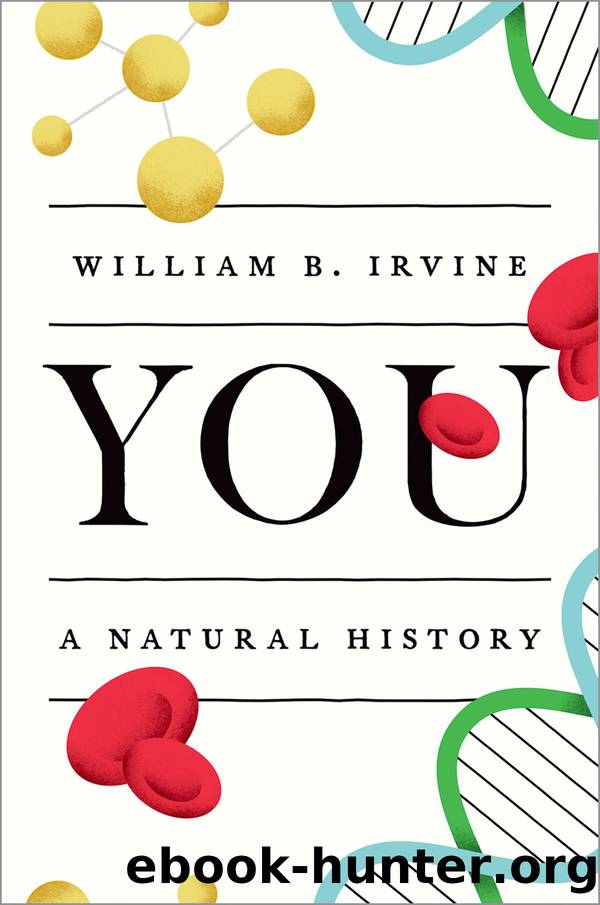You by William B. Irvine

Author:William B. Irvine
Language: eng
Format: epub
Publisher: Oxford University Press
Published: 2018-07-15T00:00:00+00:00
PART III
The Atomic You
13
You Are What You Eat, Ate
So far, we have taken you to be a person, a member of a species, and a collection of cells, but these arenât the only ways in which you can be understood. Ask a physicist what you are, and the likely response will be âa collection of atoms.â The physicist might go on to reveal that if you weigh, say, 155 pounds (70 kilograms), you are composed of approximately 6.7 Ã 1027â6.7 billion billion billionâof them.1
At birth, you might have weighed 9 pounds (4 kilograms) and been comprised of 0.4 Ã 1027 atoms. Where did the additional 6.3 Ã 1027 atoms come from? The naive answer to this question, offered by a surprising number of people, is that these atoms âare just thereâ or that your body somehow made them. Such responses indicate a failure to appreciate one of the most basic principles of physics, the Law of Conservation of Mass: although mass can be moved around, it canât be created or destroyedânot, at any rate, in the normal course of things.2 This means that you didnât create any of the atoms in you. You simply borrowed them from the outside world. And when you are done with them, that is where they will return.
When an atom enters a living thing, various chemical processes go to work on it. As a result, a solitary atom might become part of a molecule, and an atom that was already part of a molecule might become part of a different molecule. The chemical transformations in question can have spectacular results. Monarch butterflies, for example, are comprised primarily of atoms that formerly belonged to the milkweed leaves that, as caterpillars, they fed on. Likewise, silk is comprised primarily of atoms that formerly belonged to the mulberry leaves that silkworms fed on.
There is an old saying that you are what you eat. Atomically speaking, this is true: the atoms that comprise you almost all come from the foods you eat and beverages you drink.3 But this aphorism also applies to other animals. Consequently, if you are a carnivore, besides being what you eat, you are what you eat, ate. Eat free-range chicken, and some of the atoms you are ingesting probably belonged to one of the bugs that the chicken hunted down. (Eating such bugs is thought by some to play a role in making free-range chickens tastier than their commercially grown counterparts.) Eat a lobster, and some of the atoms you are ingesting might previously have belonged to the decaying fish that the lobster scavenged.
It is natural to think of the atoms that comprise you as being âyourâ atoms, but in fact they had long histories before becoming part of you; indeed, some of them have been around for nearly 13.8 billion years. And when you die, these atoms wonât cease to exist. They will continue to exist in your remains, or they might move on to become part of some other living thing. In all likelihood they will outlast you by billions of years.
Download
This site does not store any files on its server. We only index and link to content provided by other sites. Please contact the content providers to delete copyright contents if any and email us, we'll remove relevant links or contents immediately.
What Happened to You? by Oprah Winfrey(1672)
Four Thousand Weeks by Oliver Burkeman(1615)
Karma by Sadhguru(1504)
This Changes Everything by Unknown(1421)
You Are a Badass: How to Stop Doubting Your Greatness and Start Living an Awesome Life by Jen Sincero(1074)
Don't Sweat the Small Stuff...and It's All Small Stuff by Richard Carlson(1012)
Infinite Circle by Bernie Glassman(964)
How to Do the Work by Dr. Nicole LePera(911)
Let's Talk About Hard Things by Anna Sale(899)
Real Strength: Build Your Resilience and Bounce Back From Anything by Psychologies Magazine(885)
Declutter Your Mind: A step by step guide to learn to control your thoughts, stop worrying, relieve anxiety and eliminate panic attacks and negative thinking by Mia Chandler(875)
The 4-Hour Workweek by Timothy Ferris(864)
The Path of Greatness--The Game of Life and How to Play It and Other Essential Works by Florence Scovel Shinn(842)
Who Moved My Cheese? by Spencer Johnson(838)
Be Your Best Self by Mike Bayer(821)
Breakup Bootcamp by Amy Chan(818)
Curative Magic by Rachel Patterson(791)
Advice for Working Moms (HBR Working Parents Series) by unknow(782)
The Self Compassion Workbook: Practical Exercises to Approach Your Thoughts, Emotions, and Actions with Kindness by Johnson LCSW Joy(781)
